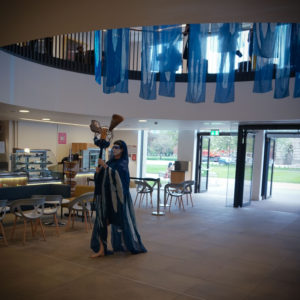Performance & Recording
Cyanotope kelp prints, Shipping forcast recitation,
Copper, Willow, Bluetooth speaker
Archive lighthouse sound recordings (Alan Renton),
Consider your footing
2017, University of Birmingham, Performed for BEAST FEaST. Made in conjunction with
Anne Parouty and Scott Wilson

2017, University of Birmingham, Performed for BEAST FEaST
Consider
Your
Footing
A Processional/Recessional ceremony
A performative response to Anne Parouty’s and Scott Wilson’s installation Kelp Road and a ceremonial signalling towards the end of the festival. Made from the shipping forecast, recordings of lighthouse fog warning signals, many of which are now silent, and remaining cyanotype prints on loan from Anne, stitched into a ritual gown.
The procession was inspired by the slow movements of the delicate kelp prints and the heavy ocean sounds of the waves crashing, cycles of the moon and methods of communication between sea farers.
Processional soundtrack
The tides are a result of the Earth’s fortuitous partnership with the moon. Our planet and it’s satellite’s movements, size and proximity cause our oceans to squeeze and bulge in regular, predictable ways. These tidal forces cause the slow oscillations we know as tides, moving masses of water across the globe and setting of numerous dynamic systems from the evolution of the first organisms to the delicate balance of local ecosystems and our changing weather systems.
No one would be more aware of the moon, the tides, the weather and it’s impact on life than sailors. The shipping forecast was originally established by Robert Fitzroy after a severe storm claimed the lives of 471 seamen aboard the Royal Charter. He felt that enough information was available to predict such events and that this information should be communicated with sailors to prevent future tragedies. A series of signals and codes was devised and the first forecast was given in 1861 via telegraphs and is thought to be the first national forecasting system in the world. Storm warnings were stopped in 1866 but public outcry and the again increased loss of life saw them reinstated in 1867. Technological advances have enabled them to be broadcast 4 times daily on the radio since 1911 and they have become a cultural icon as well as a source of potentially life saving information for those without access to their own meteorological data.
Similarly lighthouses have been used to aid navigation and preserve life by communicating information about local hazards across large distances. Lighthouses have seen many technological advances – starting at first as wood or coal fires, progressing to oil lamps (vegetable or whale) now electric bulbs and LED lamps. Each lighthouse has it’s own unique signatures of light patterns, and many lighthouses also feature fog horns for warning in low visibility weather, each too with it’s own unique call. Modern technology of GPS and other on board navigational devices has lead to the decommissioning of many lighthouses and the automation of those remaining. The impact of these changes on coastal communities has been vast.
Get updates about future events
We will process the personal data you have supplied in accordance with our privacy policy.






